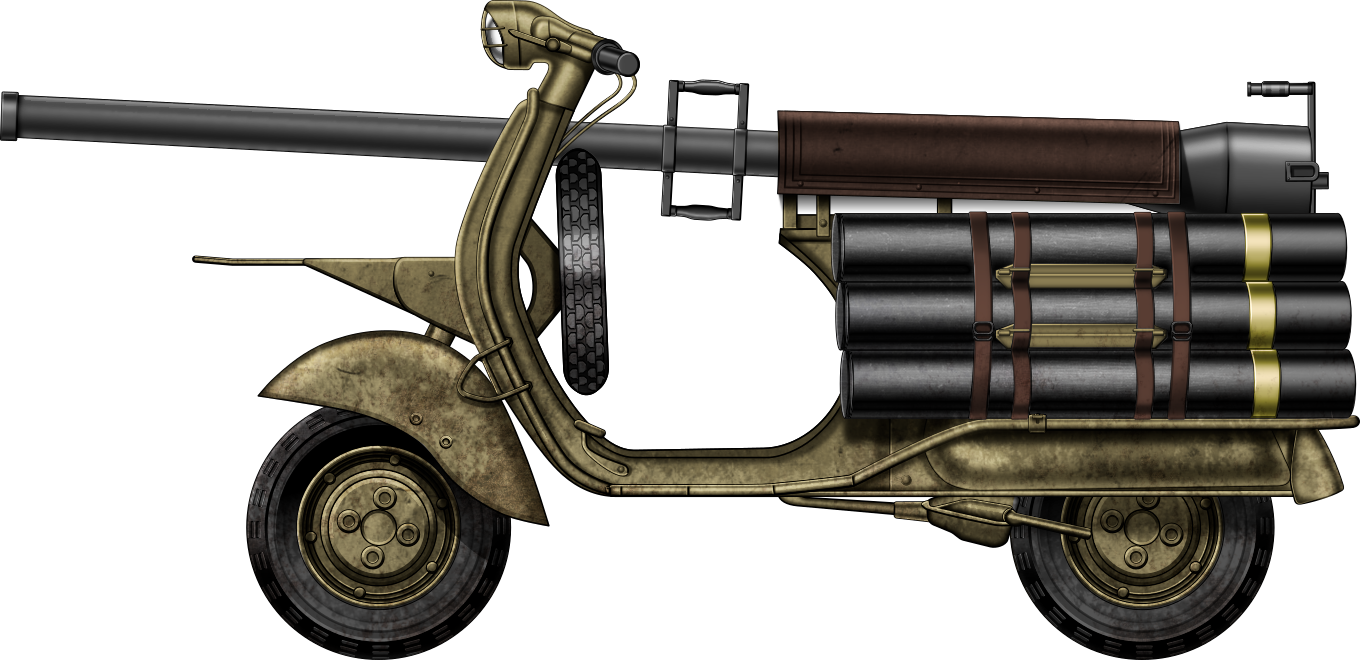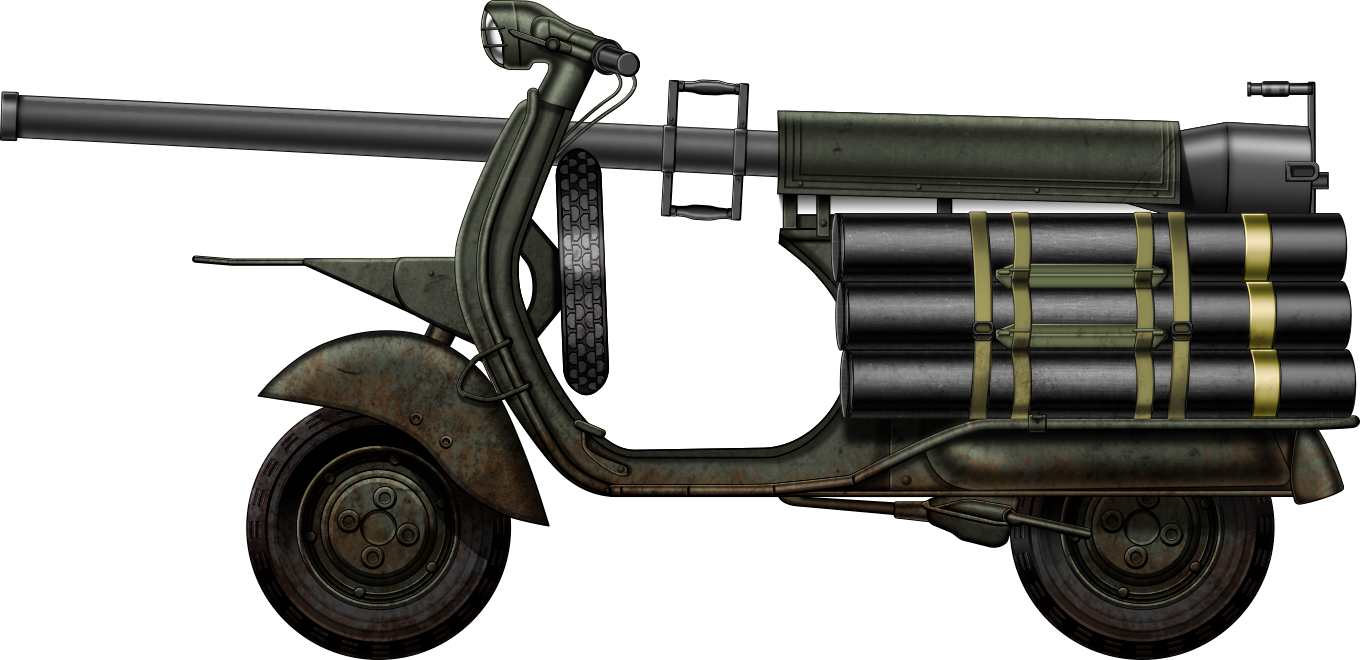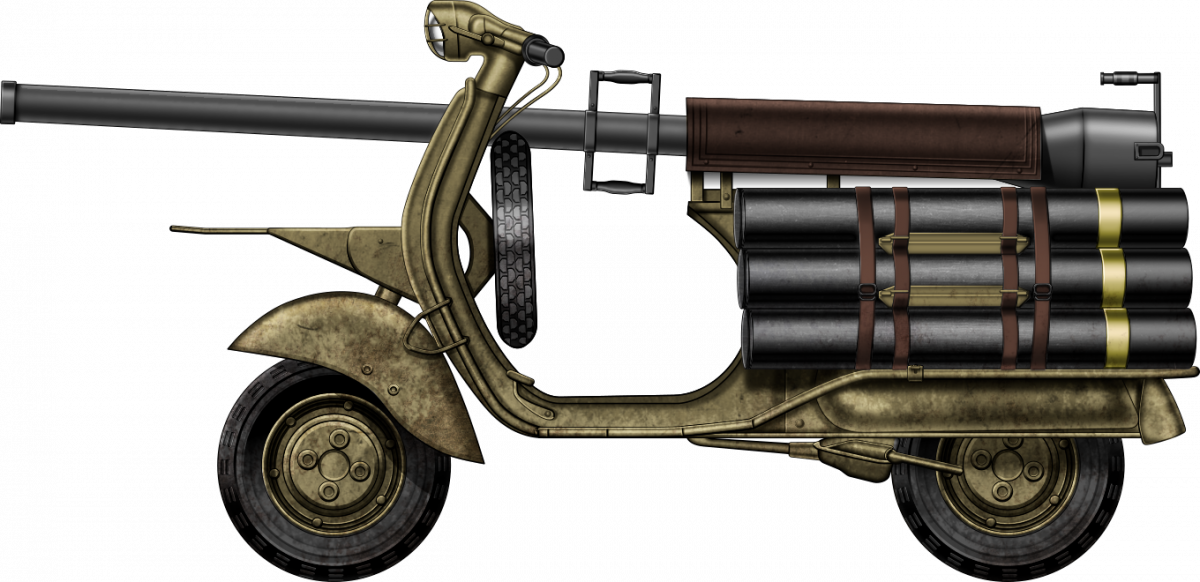 France (1956-1960)
France (1956-1960)
Anti-Tank Weapon Carrier – 600~800 Built
The Piaggio Vespa TAP [Troupes AéroPortées] (English: Airborne troops) 56 and 59 were French-developed military motorbikes, based on the iconic Vespa, Italy’s most famous two-wheeler. The Vespa TAP carried a US M20 75 mm recoilless rifle with the aim of countering enemy light armored vehicles with an agile and robust vehicle that could be parachuted in where it was needed.

Source: ruotedasogno.com
The Vespa: how to motorise the Italian people after the Second World War
During the latter period of the war, Piaggio studied how to convert military factories to adapt them to the production of civilian vehicles, especially at the technical offices in Pontedera, which had moved to Biella during the period of the Repubblica Sociale Italiana (English: Italian Social Republic). There, Piaggio technicians studied this problem. After the end of the Second World War, the Regno d’Italia (English: Kingdom of Italy) – which became Repubblica Italiana (English: Italian Republic) after the referendum of 2nd June 1946 – was devastated. The railways and road infrastructure were in a pitiful state. There was a serious lack of public vehicles and it was essential for the country to provide the population with cheap, practical, and fuel-efficient vehicles so that communications and travel could be resumed.
Already in 1944, a motorbike with these characteristics had been produced, the MP5, called ‘Paperino’ (English: Donald Duck), but this motorbike did not satisfy Enrico Piaggio, the owner of Piaggio, together with his brother Armando. They asked engineer Corradino D’Ascanio to revise the design. Armando Piaggio did not like the Paperino at all and, together with his collaborator, Mario D’Este, created the MP6 in April 1946, which took the name Vespa (English: Wasp) because of its shape.

Source: vespaforever

Source: pinterest @First Versions
On 23rd April 1946, the new vehicle was patented under the name of Motocicletta a Complesso Razionale di Organi ed Elementi con Telaio Combinato con Parafanghi e Cofano Ricoprenti tutta la Parte Meccanica, a real long name meant to designate a fully metallic bodywork. Mass production was immediately started for 2,000 Vespa 98s with a 98 cm3 engine.

Source: stream24.ilsole24ore.com
There is an urban legend that claims that the Vespa‘s wheels and engine were the tail wheel and starter engine of the Italian Piaggio P.108 four-engine bomber, respectively, but no aeronautical components were actually used on the Vespa.
The vehicle was very successful. 19,822 had been produced by 1948 and new versions with 125 and 150 cm3 engines were developed in the late 1940s and early 1950s. The vehicle was also successful abroad. In 1951, the French ACMA – Ateliers de Construction de Motocycles et Accessoires (English: Workshops for the Construction of Motorbikes and Accessories) workshops began license production of the Vespa. In later years, it was produced by Messerschmitt and Hoffmann in Germany, Douglas in Great Britain, MISA in Belgium and Moto Vespa S.A. in Spain. In a short time, the Vespa was produced in 13 countries and marketed in 114.
The first military Vespa
In the early 1950s, the French army needed a light and robust vehicle capable of carrying an anti-tank weapon, for units deployed in Indochina that had to deal against the badly armed Viet Minh communist militias. The scooter was preferred in favor of heavier vehicles because it was light, agile and robust and could be parachuted into inaccessible areas or behind enemy lines. Thus, the Piaggio Vespa Troupes Aéro Portées 56 was born, to be followed three years later by the 59 model used by the Légion Etrangère (English: French Foreign Legion) and paratroopers.

Source: vespa tecnica

Source: vespa tecnica

Source; vintagescooters
Design
Hull
The chassis was reinforced by a metal tube that surrounded the vehicle and served to protect it from impacts and to support the side ammunition carriers. The front mudguard was much smaller than on other Vespe. Above it, there was a rack supported by four bolts fixed to the reinforcing tube at the front of the ‘shield’ – the term ‘shield’ on the Vespa refers to the sheet metal that protected the rider and on which the handlebar was mounted -.

Source: automotorinews

Source: vespa tecnica
Underneath the shield were two sturdy independent brackets that acted as a tripod and were put into position by rotating them outwards. On the inside of the shield were two slots that served to hook the parachute.
On the left side of the shield was an open hole through which the cannon was placed. The hole was reinforced with a leather padding held by rivets that prevented the cannon from rubbing against the plate.
The rifle was fixed under the saddle on a special metal trapeze; the saddle could be opened sideways to allow the cannon to be removed from the vehicle and be used as a field weapon.

Source: quattromania.it

Source: vespa tecnica
The rear of the vehicle was left open and a rubber mud flap was inserted in place of the sheet metal, which also acted as a plate holder.

Source: vintagescooters
Under the chassis, there were reinforcements protecting the engine and muffler and also metal-coated rubber padding to prevent the vehicle from breaking during parachute jumps.

Source: vespa tecnica
The military Vespa was delivered in two colors, sand yellow or dark green. The Vespa could carry a small one-wheeled trolley to transport useful material. The only difference between the two models was that in the 56, the ACMA badge, located on the inside of the shield, was metal while on the 59, it was plastic.

Source: la stampa
Engine
The engine was the same as on the Vespa VL3 “Struzzo” (English: Ostrich), a 150 cm3 single-cylinder two-stroke engine with a three-speed gearbox. The transmission was modified by making the gear ratios shorter to adapt the Vespa to carry the greater weight. The carburettor was also changed from a Dell’Orto MA 19 to a Gurtner. The only engine difference between the models 56 and 59 was that, in the former, the cylinder cover was made of aluminum while, in the latter, it was made of sheet metal.
The Vespa could reach a top speed of 66 km/h and had a range of 200 km, which could be increased thanks to the two oil and fuel tanks carried on the luggage rack.

Source: vespa tecnica
Armament
Although this vehicle is often called the Vespa Bazooka on the internet, it was actually armed with a US-made M20 recoilless rifle of 75 mm caliber. The weapon could not fire while mounted on the vehicle. It had to be dismounted from it and used as a field weapon; the M20 rifle was mounted on the tripod of the M1917A1 machine gun.

Source: weaponsystems.net
The breech is constructed so that, on ignition of the propellant charge, the resultant gasses are allowed to escape to the rear through orifices in the breechblock, thereby eliminating recoil. The gas escape orifices are so designed that the momentum of gas discharge effectively counteracts the momentum of recoil and the angular momentum induced by the motion of the fired shell, and the rifle remains motionless. The M20 had a depression angle of -27° and an elevation angle of +65°.
The M20 was developed in 1944, being used by US forces in the final parts of the Second World War. The rifle was later used during the Korean War in the early 1950s, but there it showed its limitations as an anti-tank weapon, as it could not penetrate the T-34/85 tanks used by North Korean forces. After this, the M20 was intended for use as an infantry support gun and to destroy bunkers. Being a light weapon, with a total weight of 75 kg together with the tripod, it was easily transportable. The rifle was used by French forces during the First Indochina War after 1946, while the Chinese versions, named Type 52 and Type 56, were used by the North Vietnamese army and Viet Cong guerrillas during the Vietnam War.

Source: vespa tecnica
Ammunition
The ammunition was carried in six ammunition boxes placed in groups of three on either side of the Vespa, that could hold one shell each. The special feature of the 75 mm rounds in the M20 rifle was the perforated casing, which was used to let propellant gasses escape into the barrel chamber. The rifle used various shells , such as the M309 High Explosive (HE) grenade, weighing 6.53 kg, with a TNT charge of 0.63 kg; the M310 High Explosive Anti Tank (HEAT) grenade, weighing 5.94 kg, which had a useful range of 400 meters and penetrating up to 100 mm of armor; and the M311 Smoke (WP) grenade, weighing 6.84 kg, which was intended to create smoke screens but could also be used to fire on enemy soldiers. There were also training and inert grenades.
HE and WP shells had a muzzle velocity of 301 m/s while the HEAT rounds had a muzzle velocity of 304 m/s.
| Ammunition for the M20 recoilless rifle | ||||
|---|---|---|---|---|
| Name | Type | Muzzle velocity in m/s | Weight (kg) | Penetration in mm |
| M309 | High-Explosive | 301 | 6.53 | // |
| M310 | High-Explosive Anti Tank | 304 | 5.94 | 100 |
| M311 | Smoke | 301 | 6.84 | 6.84 |

Source: wikipedia

Source: wikipedia
Crew
The Vespa was usually driven by a single soldier, but there could be a passenger if necessary, although the added weight certainly affected the ride.

Source: esquire.com
Operational Use
Between 600 and 800 Piaggio Vespa T.A.P. 56 and 59 were built from 1956 to 1959. They did not participate in the war in Indochina, which had ended in 1954. It was used by paratroopers and the French Foreign Legion in the Algerian War, a conflict that lasted between 1954 and 1962, fought between French forces and Algerian independence fighters, who eventually won the war, which led to the independence of the country.
The M20 rifle carried by the Vespa was very useful for destroying the fortifications and light armored vehicles of the Armée de Libération nationale (English: National Liberation Army – NLA -) i.e. the Algerian Independence Army. However, there is no further information on the use of the Vespa in Algeria or on other fronts.
It is unclear when these were withdrawn from service.

Source: myktm.it

Source: myktm.it

Source: myktm.it
Conclusion
Due to lack of information, it is difficult to provide an assessment of the vehicle as a military asset to the French forces. As it appears, the Vespa T.A.P. was not a great success in the military but, today, it is highly sought after by collectors. In 2020, a Vespa T.A.P. 56 was sold by Ruote da Sogno, a Italian classic car and motorcycle dealer, for €40,000.
Video


Specifications of the Piaggio Vespa T.A.P. 56 |
|
|---|---|
| Dimensions (Length, Width and Height) | 1.76 x 0.69 x 1.11 m |
| Weight | 115 kg |
| Engine | Two-stroke single cylinder 150 cm3 |
| Maximum speed | 66 km/h |
| Range | 200 km |
| Armament | M20 recoilless rifle |
| Ammunition | Six 75 mm grenades |
| Crew | 1 – 2 |
| Production | Between 600 and 800 units |
Sources
Roberto Leandri, Luigi Frisinghelli and Giorgio Notari “Vespa Tecnica 4. Record and special production” Fornacette 2001
Department of the Army “75-mm Rifle M20” Washington 1948
https://www.museopiaggio.it/it/collezioni/1-vespa/11-150-t-a-p
Roberto Leandri, Luigi Frisinghelli and Giorgio Notari “Vespa Tecnica 1. 1946 to 1955” Pontedera 1998
https://www.motociclismo.it/vespa-la-nascita-i-record-la-storia-e-i-modelli-dal-1946-a-oggi-65204
http://medcmd.mil.kr/user/imhc/upload/pblictn/PBLICTNEBOOK_202105270240172800.pdf
http://vintagescooters.free.fr/vespa/acma/v_acma150tap-56.htm
https://www.motorcyclespecs.co.za/model/Vespa/Vespa%20150%20TAP.htm


2 replies on “Piaggio Vespa TAP 56 and 59”
“The weapon could not fire while mounted on the vehicle.”
Is there any specific reason this couldn’t be done, other than it being a really, REALLY bad idea probably?
Is the trigger in a place where you couldn’t get a piece of rope around it or so?
The ultimate French weapon of mass destruction – a weapon to surpass Metal Gear one might say